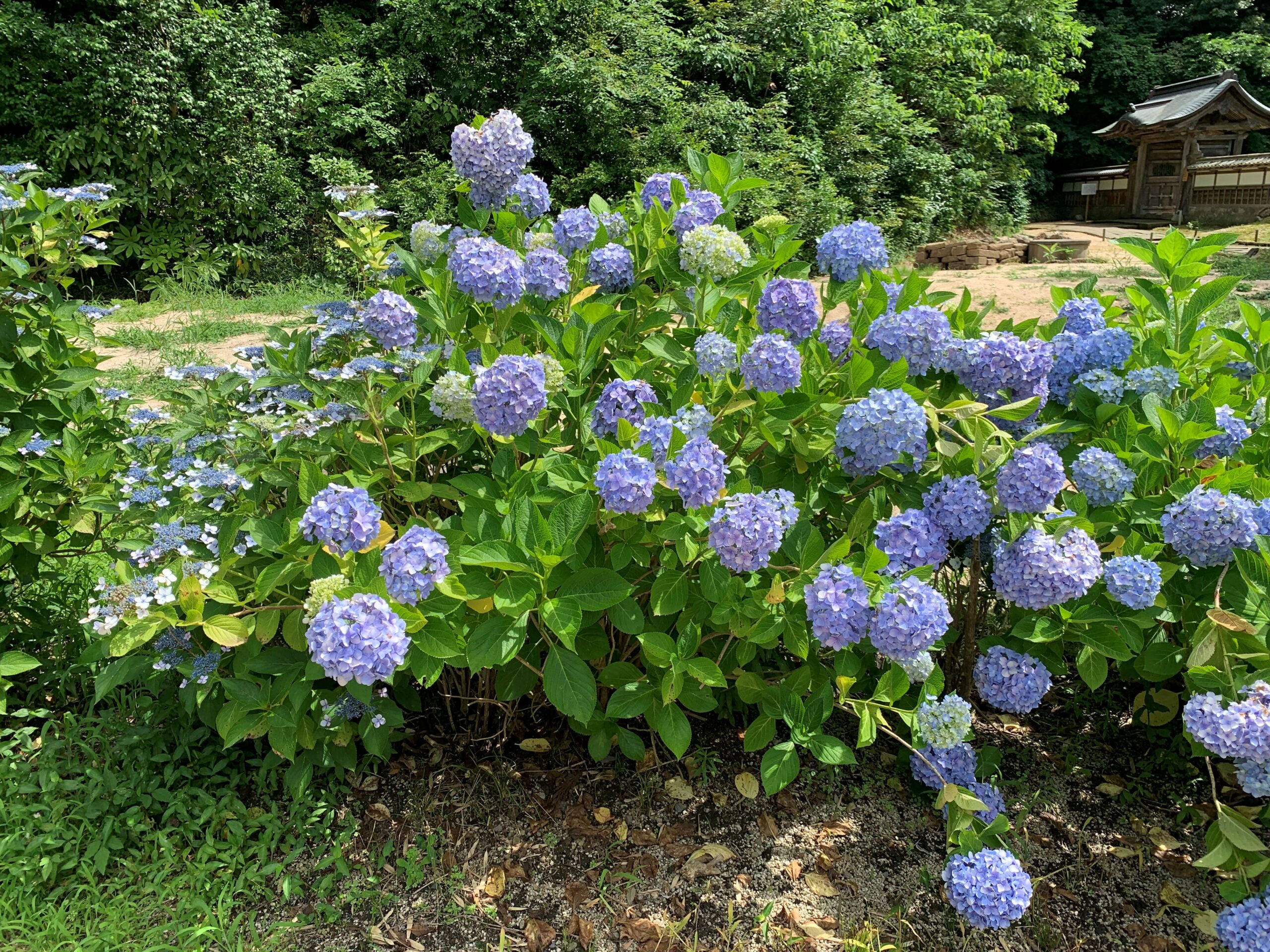Although the Japanese rainy season can evoke a sense of melancholy, it brings vivid colour to the hydrangeas at Gessho-ji Temple.
Temple’s Origin Story
Initially, the Zen temple known as Touun-ji underwent a significant transformation at Gessho-ji. To enshrine the spirit memorial tablet of his mother, Gesshō-in, Lord Naomasa Matsudaira, the first lord of Matsue, invited a Jōdo-sect monk and revived the temple in 1664. It was at this time that the temple was renamed (Kangizan) Gessho-ji and converted to the Jōdo sect. After his death, it has served as the Matsudaira clan’s revered family temple.
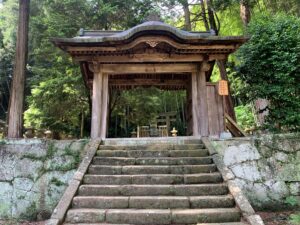
Jōdo Sect and Salvation for All
The Jōdo (Pure Land) sect is a Japanese Buddhist denomination founded in the early Kamakura period. Its teachings emphasise that by believing in salvation and reciting the nenbutsu (a prayer to Amitābha Buddha), anyone can achieve rebirth in the Pure Land of Sukhāvatī after death. This accessible doctrine, offering salvation through the compassion of Amitābha Buddha even to those unable to undertake rigorous ascetic practice, appealed to a wide range of people—from commoners to the ruling class.
Destruction and Resilience
The temple faced a challenging period with the advent of the Meiji Restoration in 1868. As the new government aimed to promote Shinto as the national religion, it issued decrees ordering the destruction of temples and Buddhist artefacts and facilities across Japan. This anti-Buddhist movement, known as Haibutsu Kishaku, led to the unfortunate demolition of Gessho-ji’s main hall.
Despite this destruction, significant elements of Gessho-ji endure to this day. Visitors can still find the tombstones bearing the names of the Matsue lords and the distinctive statue of a turtle, revered as a loyal servant of the sixth Matsudaira daimyo. These resilient remnants offer a tangible link to the temple’s profound history, even after the dramatic shifts of the Meiji era.
Getting to Gessho-ji
Thanks to Japan’s efficient transportation system, reaching Matsue is a breeze. Sunrise Izumo sleeper train offers a 12-hour ride from Tokyo to Matsue Station, complete with private cabins and scenic views, for about 50,000 yen ($450) round-trip. Alternatively, Shinkansen whisks you there in about eight hours, with a change at Okayama Station to the Local Limited Express Yakumo for under 40,000 yen round-trip. Once at Matsue Station, visitors can easily reach Gessho-Ji Temple by bus, taxi, or a scenic bicycle ride along the lake and castle.
Nestled in Matsue—a city distinct from Tokyo or Kyoto, one that has forged its own unique path of development since ancient times, steeped in myth and embodying Japan’s authentic original landscape—the temple exudes a quiet dignity that has captivated both domestic and international visitors alike.
Located to the north of Matsue Castle, Gessho-ji Temple’s position may not be a coincidence. In Buddhist tradition, the north is associated with the direction in which the historical Buddha, Shakyamuni, passed into Nirvana. This symbolic orientation is said to represent a space dedicated to the peaceful repose of the soul—a quiet sanctuary for the departed.
Garden of Blossoms and Memories
From June to July, approximately 30,000 hydrangeas bloom throughout the temple grounds. The flowers seem to echo the gentle presence of the Matsudaira lords’ princesses and concubines, creating a tender contrast with the solemnity of the stone monuments.
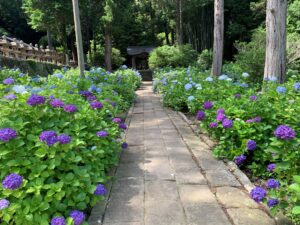
In early summer, lotus flowers also grace the temple grounds. In Buddhist belief, the lotus is revered as a symbol of purity and rebirth—its ability to bloom unsullied in muddy water reflects the spiritual journey toward enlightenment. Often associated with the Pure Land of Amitābha Buddha, the lotus adds a serene, sacred beauty to Gessho-ji’s already tranquil atmosphere.
Global Voices on Gessho-ji
Gessho-ji Temple draws not only local visitors but also admirers from abroad. One notable example is Lafcadio Hearn, whose writings continue to shape the world’s understanding of Japanese culture. His deep affection for Gessho-ji reflects his lifelong devotion to uncovering the soul of Japan. In his seminal work, Kwaidan, he introduced the legend of the temple’s stone turtle to Western readers. According to the temple’s guide, Hearn was especially fond of Gessho-ji. His wife, Setsu, recalled him saying, ‘This is my favourite place. I want to be buried here, too.’
—Lafcadio Hearn, ‘The Chief City of the Province of the Gods’, in Glimpses of Unfamiliar Japan
Another admirer of Matsue appeared nearly a century later. In 1959, a young U.S. Air Force officer, Walter J. Humphrey, came to Matsue and fell in love with the city, often visiting Gessho-ji. After completing his commission in the Air Force, he became an English teacher in the castle city, just like his senpai—a Japanese term referring to a senior or respected predecessor, especially in a school or work context. Later, the first lieutenant obtained a doctorate from Oregon State University. In his memoir, he wrote:
‘One of the first places I visited was Gesshoji. It may surprise many people to learn that in 1959, it wasn’t as beautiful as it is today. In fact, it was rather rundown. Some of the tombs were very, very small and not even made of stone, as they are today.
[…]
Gesshoji today is a lovely tourist attraction, full of hydrangeas, irises, and other beautiful flowers. It is in superb condition, with its own museum, shops, and even a restaurant. There’s a charming little pond with turtles, which delight the children’.
—Walter J. Humphery. (2020). 月照寺- Gesshoji. 英語対訳で読む日本の文化,https://japanese-culture.info/
In 1982, Dr. Kenneth M. Roemer, an emeritus professor at the University of Texas at Arlington, visited Matsue as a visiting professor at Shimane University. He described Gessho-ji as follows:
‘In Gesshoji, the Matsudaira burial grounds, there lives a monstrous stone turtle posed before a row of stone lanterns. Hearn estimated its length at 17 feet.
[…]
But in feudal times after dark, the villagers saw him roaming the streets, his protruding neck directed toward a nearby lotus pond and other favourite haunts. […]
Indeed, there is a crack about a foot below the sculptured line that divides his head from the trunk of his bulging neck.’
—Kenneth M. Roemer, ‘Entry Ways’, in A Sidewalker’s Japan: Impression Encounters
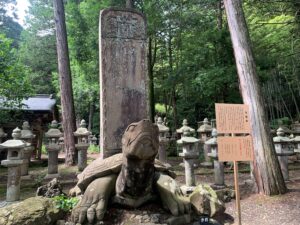
Then, Caroline Kano, a former professor at Shimane Prefectural Shimane Women’s College and later a specially appointed professor at Tokyo University of Foreign Studies, was also captivated by the atmosphere of the temple—an enduring symbol of Matsue’s cultural refinement. Her journey from London to the Chief City of the Province of the Gods — guided by the legacy of Hearn—can be seen as an expression of the Buddhist concept of engi, or an intangible thread that connects the past to the present.
‘As one enters these tranquil precincts, the reality of the mundane world without, evaporates as with a spell of magic which seems to pervade the air. Venturing softly from tomb to tomb, slipping back in time from generation to generation of the former Edo rulers of Matsue, it is as if, charmed by the bewitching quality of the atmosphere, one has unconsciously embarked upon an unknown journey.
[…]
Momentarily, these hydrangeas before one are transported to a distant plane, a different clime, where they bloom in the fond gardens and parks of the memory, as a very English flower. As this image softly disperses, however, and merges once more with the hydrangeas of Gesshoji in this Season of Rain, it is strange how they seem to have taken on a new aspect, how they now appear so intrinsically Japanese.’
—David Smith and Caroline Kano, ‘Gesshoji’, in Journey to the San’in: Paintings and Appreciations of Japan
Living Temple, Timeless and True
Gessho-ji Temple, with its feudal elegance preserved in stone and garden, offers a poignant contrast between the ephemeral bloom of hydrangeas and the enduring silence of ancestral tombs, inviting those who walk its paths to begin uncovering the soul of Japan.
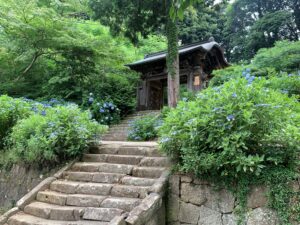
Tea Master’s Legacy
The seventh lord of the Matsue Domain, Matsudaira Harusato—better known by his tea master name, Fumai-kō—was a distinguished patron of tea culture. Within the temple grounds, one can still find a spring that he is said to have cherished. This spring continues to flow with pristine water, now used to prepare matcha (powdered green tea) for temple guests. Sipping this carefully prepared tea while gazing upon the serene landscape, one may well forget the passing of time. In addition to the mausoleums of successive lords, the temple grounds also preserve Daien-an, a tea house associated with Fumai-kō, and Chasen-zuka, where tea whisks are ceremonially offered.
Echoes in Present
Today, as visitors from around the world follow in the footsteps of Hearn and his spiritual successors, one can sense that the soul of Matsue still lingers among the hydrangeas, stone paths, and silent tombs. International residents, including Assistant Language Teachers (ALTs) and Coordinators for International Relations (CIRs), are drawn to the temple’s quiet beauty and visit Gessho-ji throughout the year, proving that the charm of this place transcends time and culture.
From a descendant of a foot soldier who journeyed from Shinshū, Nagano Prefecture, to Matsue with Lord Naomasa, the first daimyo of the Matsue domain.
(Words by Takashi Saito)
179 Uchinakahara, Matsue
How to Get to Gessho-Ji Temple
From JR Matsue Station, visitors can take either the Matsue Lake Line Bus by the Matsue City Bus or the Ichidata Bus for Etomo or Mitsu. Get off at the Gessho-Ji Iriguchi bus stop (approximately 15 minutes). The school building in front of the bus stop is a convenient landmark. Walk to Gessho-ji Temple: Approximately 8 minutes.
Gurutto Matsue Lake Line
- Departure: Matsue Station (Kokuhō Matsue Castle-mae Bus Stop)
- Arrival: Gessho-ji Temple-mae Bus Stop –
- Fare: ¥210
Etomo Mitsu-bound Bus
- Departure: Matsue Station (Kenmin Kaikan-mae Bus Stop)
- Arrival: Gessho-ji Temple Entrance Bus Stop
- Fare: ¥210
Business Hours (2025)
- Temple: 10:00 am – 4:00 pm
- Tea Lounge: 10:30 am – 3:30 pm (Green tea with Japanese confectionery: ¥600 per person)
Note: Admission is allowed up to 30 minutes before closing time in all seasons.
Admission Fees
- Adults: ¥700
- Junior and High School Students: ¥500
- Elementary School Students: ¥500

